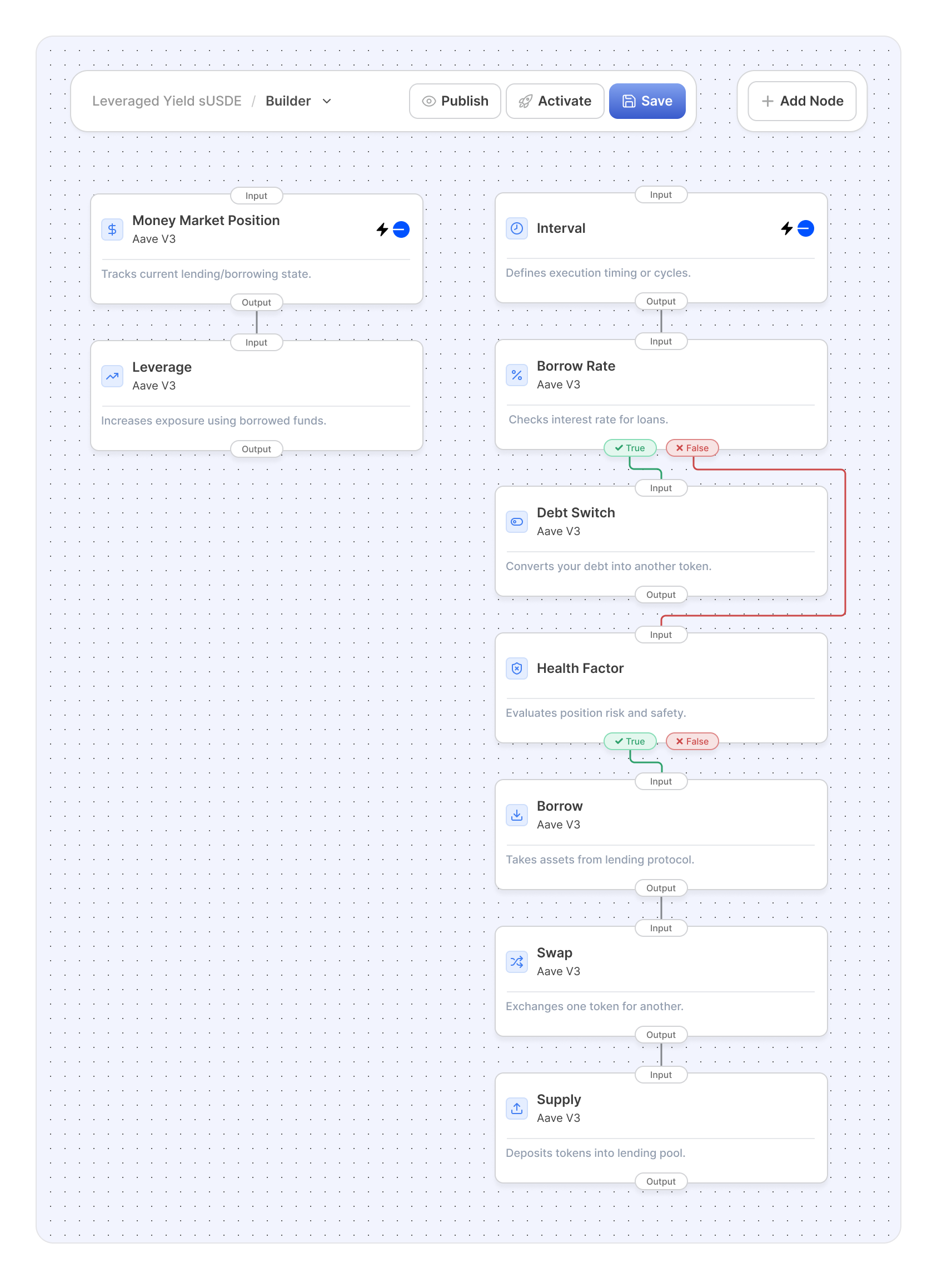#
Leverage-Yield Strategy with sUSDE on Aave
#
Introduction
This strategy leverages stablecoin lending and borrowing on Aave to amplify the native yield of sUSDE, a staked variant of USDE with built-in interest. By repeatedly using sUSDE as collateral to borrow stablecoins and swapping the borrowed assets back into sUSDE, investors create a leveraged position that enhances yield through compounded interest effects. No manual capital addition is required once deployed.
- Token: sUSDE (staked USDE with native yield)
- Protocols: Aave (lending & borrowing), 1inch/Uniswap (swaps)
- Target Audience: Advanced DeFi users with lending and risk management experience
- Goal: Build leverage on native sUSDE yield

#
Strategy Explanation
#
Entry Steps
- Start with USDC capital.
- Swap USDC into sUSDE.
- Deposit sUSDE as collateral on Aave.
- Borrow the cheapest stablecoin available on Aave (e.g., USDC or DAI).
- Swap borrowed stablecoin back into sUSDE.
- Repeat deposit and borrow steps (loop) until the desired risk level is reached.
#
Rebalancing Mechanism with Auto Compounding and Debt Optimization
To maximize yield and keep borrowing costs minimal, the strategy incorporates:
- Auto Compounding of sUSDE Yield: Accrued native sUSDE interest is automatically claimed and reinvested to increase collateral balance, thus increasing overall exposure and yield amplification without manual intervention.
- Flashloan-Based Debt Switching: The strategy continuously monitors borrowing rates across supported stablecoins on Aave. When a cheaper borrow rate is available (e.g., switching from USDC to DAI), it uses flashloans within the same blockchain transaction to:
- Borrow the cheaper stablecoin via flashloan.
- Repay existing debt immediately with it.
- Release collateral as needed, then re-borrow the cheaper stablecoin.
- Repay the flashloan instantly.
This dynamic debt switching optimizes borrowing costs, ensuring the lowest possible interest expense, which increases net yields. Both mechanisms run in an automated fashion to minimize risk and maximize capital efficiency.
#
Advantages
- Enhanced Compound Yield: Native sUSDE yield (~7-12% APY in 2025) amplified by leverage (up to ~3.1×), with auto compounding to magnify returns continuously.
- Flexible Risk Profile: Number of loops can be tailored to risk appetite.
- Dynamic Borrow Optimization: Continuous flashloan rebalancing secures the lowest borrowing interest rate, improving net yield.
- Automation Friendly: Fully automatable with DeFi scripts, strategy builders, or smart contract execution.
#
Suitable For
- Experienced DeFi investors familiar with lending, liquidation, and risk management.
- Yield-driven stablecoin investors wanting passive income maximization.
- Users understanding leverage risks (liquidations from interest rate or collateral factor changes).
#
Why This Strategy?
- Stablecoin leverage is lower risk than volatile asset leverage due to price stability.
- sUSDE provides a native yield between ~7% and 12% APY as of 2025.
- Borrowing the cheapest stablecoin and switching debt actively maximizes capital efficiency by minimizing interest expenses.
#
Example: Leveraged sUSDE Yield with Auto Compounding and Debt Optimization
#
Leveraged Yield Calculation
With a leverage of 3.1×, the collateral and debt scale accordingly:
- Collateral = 10,000 \times 3.1 = 31,000 sUSDE
- Debt ≈ 31,000 \times 70\% = 21,700 USDC borrowed
Yield and fee estimates:
- Gross yield = 31,000 \times 10\% = 3,100 USDC/year
- Borrowing fee = 21,700 \times 5\% = 1,085 USDC/year
- Net yield = 3,100 - 1,085 = 2,015 USDC/year
Effective return on initial equity (10,000 USDC):
\frac{2,015}{10,000} = 20.15\% \text{ p.a.}Factoring auto compounding and optimized borrowing rate (closer to 4.5% borrow rate) pushes net yield further toward ~22% APY.
#
Simplified Loop Process
Repeat the deposit, borrow, and swap cycle 4 or more times to approach 3.1× leverage, while continuously auto-compounding yield and rebalancing debt.
#
E-Mode Amplification
By activating Aave’s E-Mode for stablecoins, sUSDE and USDe can be looped with a max LTV of 90% (compared to standard 70%), letting you push leverage ratios much higher. The theoretical max leverage with E-Mode is:
\text{Leverage} = \frac{1}{1 - \text{LTV}} = \frac{1}{1 - 0.9} \approx 10 \timesYield optimization analyses confirm looping can yield approximately 60% APY before incentives and fees, with practical results often in the 40–50% APY range depending on market conditions, borrow rates, and loop counts.
#
Leveraged Yield Calculation (E-Mode)
- Collateral = 10,000 \times 10 = 100,000 sUSDE
- Debt ≈ 100,000 \times 90\% = 90,000 USDC borrowed
- Gross yield = 100,000 \times 10\% = 10,000 USDC/year
- Borrowing fee = 90,000 \times 5\% = 4,500 USDC/year
- Net yield = 10,000 - 4,500 = 5,500 USDC/year
Effective return on initial equity (10,000 USDC):
\frac{5,500}{10,000} = 55\% \text{ p.a.}Allowing for auto compounding and highly optimized borrowing (possibly <5%), practical APYs achieved via E-Mode have ranged between 40% and 60%, as confirmed by recent DeFi reports and on-chain data for Q3 2025.
#
Risks
- Liquidation Risk: Higher leverage increases liquidation likelihood if borrow rates rise or collateral value/dynamics change.
- Protocol Risk: Potential vulnerabilities in Aave, sUSDE contracts or flashloan mechanisms.
- Interest Rate Risk: Rates fluctuations require active rebalancing to sustain yield.
- Automation Risk: Fully relying on scripts and automation requires robust infrastructure.
#
Summary
Increasing leverage to about 3.1× at 70% LTV enhances the strategy's effective APY from 17.7% to around 22% annually. Enabling E-Mode amplifies leverage up to 10× with effective APYs near 60%, although it requires heightened risk management and automation to avoid liquidations and maintain stable net yields.
APY estimates leverage 2025 market data with optimized borrowing rates reduced by flashloan rebalancing and auto compounding of the sUSDE native yield.
[Sources: Aave statistics, Ethena updates, DeFi automation reports 2025]

